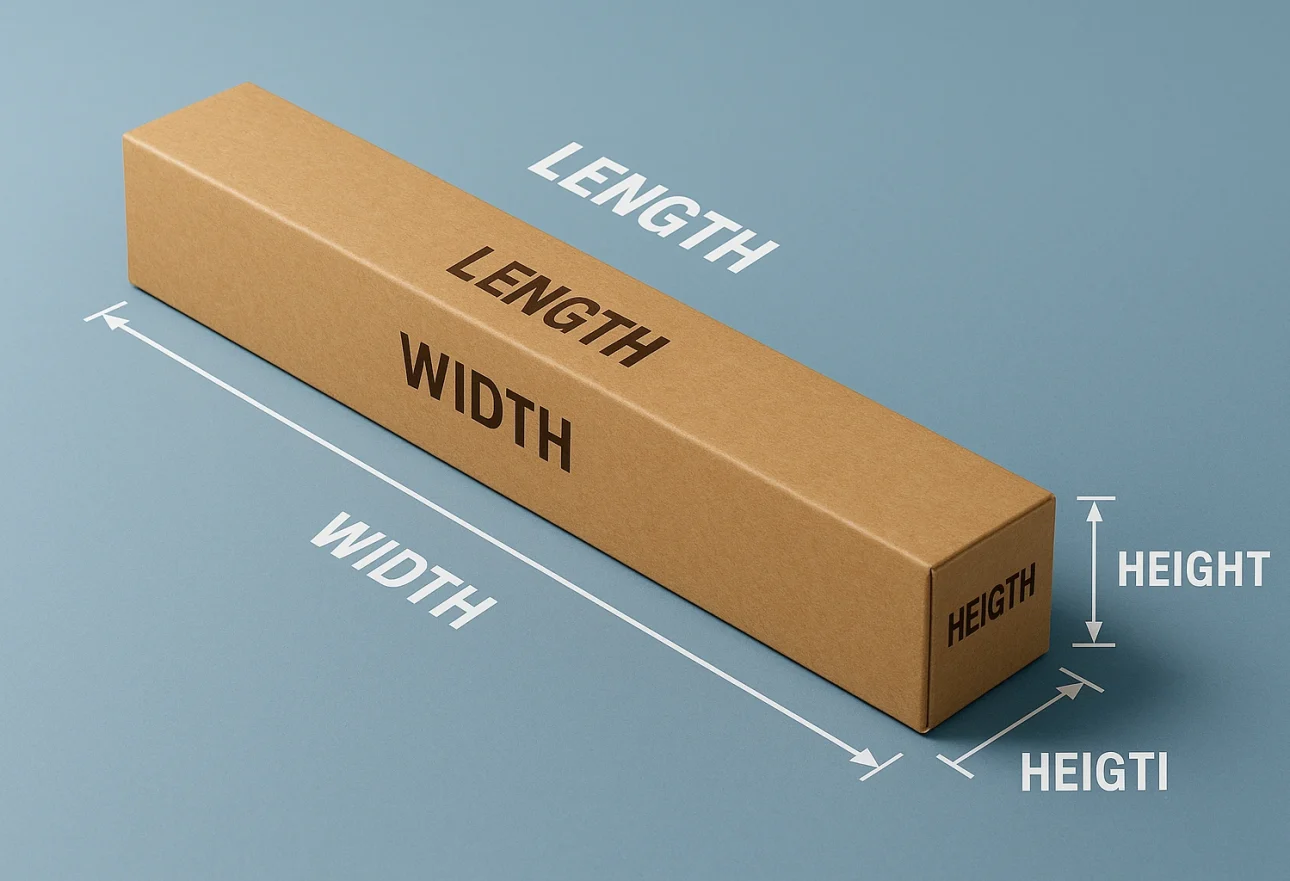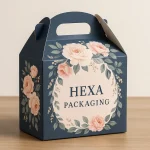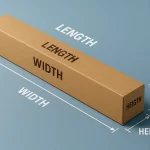When it comes to understanding the actual dimensions of a physical object the three basic measurements are length, width, and height. These three values collectively tell how much space something takes up visually and bodily. Whether it is a container, a bag, a delivery parcel or maybe an easy household item, these measurements decide its capacity and size.
In the sector of custom packaging, expertise in the length × width × height method isn’t simplest beneficial, but crucial. Getting these numbers right guarantees that you’re packaging suits your merchandise perfectly, prevents damage during transit, and enhances the presentation’s pleasantness.
Let’s take a deeper dive into what each of these measurements implies, how to calculate them, and why they are so crucial within the packaging industry.
Importance of Measuring Dimensions Correctly
Dimensions are the language of length. They describe how huge or small an item is and help manufacturers, designers, and shippers ensure accuracy in manufacturing and transport. In packaging, even a distinction of half an inch can make a substantial effect. Boxes may not be in shape properly, products can get damaged, or substances may go to waste.
The duration, width, and height together define an object’s form and volume.
- For rectangular boxes, these three measurements are sufficient to calculate space and capacity.
- For abnormal shapes, different geometric factors can also come into play; however, those three stay the base of all dimensional calculations.
In brief, understanding the way to degree a container nicely ensures a specific, price-powerful, and visually balanced packaging solution.
What Does Length × Width × Height Mean?
The Length Width and Height (L×W×H) system calculates the volume or cubic space an item occupies. This is the maximum common manner to describe packing containers, parcels, or any three-dimensional item.
For example, while a packaging supplier says a container’s dimensions are ten” × eight” × five”, it means:
- Length: 10 inches (from left to proper)
- Width: 8 inches (from front to back)
- Height: 5 inches (from bottom to top)
These three values help decide:
- How many products can fit inside the container
- The shipping fee (primarily based on dimensional weight)
- The aesthetic percentage of the box layout
In packaging, these numbers form the blueprint for production, printing, and transport logistics.
The Standard Order of Dimensions: L × W × H
Whenever you read or write field dimensions, it’s essential to follow the usual order:
Length × Width × Height
This order enables maintaining consistency across the packaging and logistics enterprise. However, the actual order you comply with when measuring may additionally vary slightly depending on the shape or orientation of your field. Let’s explore the way it differs:
- Height Width Length (Vertical Boxes)
If you’re measuring a vertical field, including a perfume or bottle field, you might degree the peak first. Then, you measure the width and duration. This method makes experience whilst the box stands upright and its height is its dominant feature.
- Height Length Width (Horizontal Boxes)
For horizontal bins, including tray fashion or square mailer containers, the peak continues to be measured first, followed by duration and width. These packing containers are broader in form, so their height is relatively smaller.
- Length Height Width (Side-View Measurement)
When you have a look at a box from the side, it regularly makes sense to measure it in this order: length, height, and width. Turning the field 90 degrees and viewing it from the front enables visualizing how those measurements relate to each other.
Regardless of the order, the components for cubic quantity stay equal:
Volume = Length × Width × Height
Length vs Width vs Height: Understanding the Difference
The simplest way to understand these three phrases is by visualizing a square box sitting on a table.
- Length: The longest side from left to right.
- Width: The shorter facet from front to returned.
- Height: The distance from the bottom to the top (how tall the field stands).
Let’s take an easy cereal box.
For example:
When viewed from the front, the tallest part is its top. Measuring facet to facet offers the width, and when you turn the container sideways, the intensity (or length) will become seen.
If a widespread cereal field measures:
- Height = 12 inches
- Length (intensity) = 7.5 inches
- Width = 2 inches
Then its quantity = 12 × 7.5 × 2 = a hundred and eighty cubic inches.
This distinction among the three dimensions defines how your product suits an excessive amount of width or no longer enough height can wreck the suit.
Step-by-Step: How to Measure Box Dimensions Correctly
To ensure your degree packing containers are as they should be, observe these easy steps:
- Prepare Your Tools:
Keep a measuring tape, ruler, and notepad ready. For small containers, an easy ruler works excellently; for larger delivery boxes, use a yardstick or long measuring tape.
- Measure the Length:
Place the box on a flat surface. Measure from the longest side of the container from left to proper.
- Measure the Width:
Next, measure the shorter aspect from the front to the back.
- Measure the Height:
Finally, the degree from the lowest to the pinnacle of the container (while status upright).
- Record in Correct Order:
Always write down your results as L × W × H, for instance, 16″ × 12″ × 8″.
By following this order, you will ensure your manufacturer or supplier translates the measurements successfully.
Tools Used to Measure Dimensions
Getting specific measurements is prime for great packaging design. Here are a few commonplace tools used to degree length, width, and height:
- Rulers: Best for small boxes or flat objects.
- Flexible Measuring Tapes: Perfect for measuring curved or massive surfaces.
- Digital Calipers: Used for thickness or very exact measurements.
- Laser Measuring Devices: For business-scale packaging or warehouse size accuracy.
These gear assist manufacturers’ layout containers that are not simply visually perfect but also structurally sound.
Why Internal Dimensions Matter More
When it involves custom field manufacturing, constantly focus on inner dimensions in preference to external ones. Internal dimensions decide how well your product fits inner.
External dimensions can be barely larger due to fabric thickness, mainly for inflexible or corrugated boxes. Measuring internally guarantees your product suits snugly and securely, preventing movement or harm throughout delivery.
For example:
- If you need to % a fragrance bottle that’s 4″ × 3″ × eight”, you’ll want to ensure the inside area of your box fits these numbers.
- If you best use outside measurements, the field may appear large but won’t shape the product tightly as soon as folded or glued.
That’s why professional packaging producers like Hexapackaging usually prioritize inner dimensions when developing custom boxes.
Measuring Volume: Calculating the Box’s Capacity
Once you realize your box’s three dimensions, you may easily calculate its volume, which represents how an awful lot area it can keep.
The basic components are:
Volume = Length × Width × Height
Let’s take an example:
A transport box has
- Length = 16 inches
- Width = 12 inches
- Height = 12 inches
So,
Volume = 16× 12 × 12 = 2,304 cubic inches
This enables manufacturers to calculate dimensional weight, which delivery companies use to determine freight prices. A better volume means extra area taken even supposing the container is lightweight.
How Dimensional Weight Impacts Shipping
In logistics, dimensional weight (DIM weight) plays a huge role. It’s now not simply the field’s actual weight that determines the cost it is additionally the space the box occupies within the delivery automobile.
Shipping providers like FedEx or UPS calculate the DIM weight the usage of the components:
(Length × Width × Height) ÷ Dimensional Factor
This ensures honest pricing for lightweight but huge applications. Understanding this precept allows brands to reduce delivery costs by designing compact, properly-sized bins that minimize wasted area.
Practical Example: Measuring a Mailer Box
Let’s observe everything you’ve learned with an instance:
You have custom mailer boxes for subscription merchandise.
Its internal measurements are:
- Length: 14 inches
- Width: 10 inches
- Height: 4 inches
Now, permit’s document it well:
L × W × H = 14 × 10 × 4
If you multiply them, you will get:
Volume = 560 cubic inches
This facilitates you to recognize precisely how much product volume can in shaped and allows your manufacturer to reduce and print materials.
Pro Tips for Accurate Measurement
Always degree from the inside of the field.
Use inches or centimeters continually do not blend gadgets.
Note measurements in order (Length × Width × Height).
Double check height specifically for bins with lids or flaps.
Avoid rounding off too early in precision subjects.
Label your notes honestly whilst sending dimensions to your dealer.
Even a small measurement error can result in significant expenses for reprinting or resizing during manufacturing.
Real-World Application in Custom Packaging
Every product has a distinct shape from cosmetics to electronics to candles. That’s why custom packaging manufacturers rely closely on correct measurements.
For example:
- A soap box may additionally have extra height than width for vertical stacking.
- A show box may also require a huge front panel for visibility.
- A mailer field needs a flat, spacious base for more than one item.
Using the perfect length, width, and height ensures each packaging kind is useful, visually balanced, and shielding.
Brands like HexaPackaging use advanced size techniques and prototyping to make certain each product from small earrings boxes to massive rigid magnetic packing containers is crafted with precision in shape and dimensions.
Final Thoughts
Mastering the Length × Width × Height concept is the muse of exact packaging design. It’s not pretty much numbers it’s approximately capability, accuracy, and logo presentation.
By understanding how to measure boxes successfully, you can:
- Save money on delivery
- Prevent product damage
- Enhance client experience
- Improve visible harmony in packaging design
Whether you’re designing a luxurious inflexible field, a preferred mailer, or an eco-friendly kraft bundle, always start with the proper dimensions measured from the interior, written inside the proper order, and calculated precisely.
In brief, ideal measurements lead to ideal packaging




